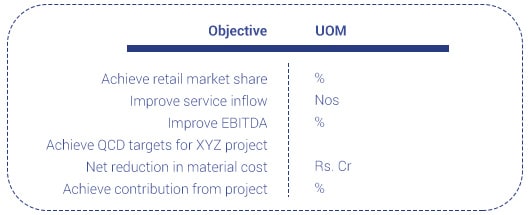A primary goal of Performance Management system is to facilitate the achievement of organization objectives. In order to successfully do so, there must be a link between the priorities and the work of individual to organization objectives. The Objective Setting (Cascading) Process ensures the alignment of individual performance objectives with the priorities and objectives of the department, and organization
Timeframe for individual annual target setting is Mar - Apr, while the process of policy management (refer annexure 1: Policy and Daily Management) for establishment of organization objectives,deployment and implementation plan in VCS form begins in Q of previous year.
Given below is the process of arriving at individual target:

There are different guidelines and IT process based on the role and work level, some of the basics of target setting applicable to remember are:
- Who: The manager and employee should collaborate to set ASMART targets in online Target Setting form (Annexure 2: Target Setting Form)
- What: The manager and employee should discuss what the individual’s Performance objectives and targets are and how they connect to the department and organization’s objectives ie Policy / MPCP (Refer Annexure 2 : Policy and Daily Management)

- Where: The discussion should take place away from disruptions, preferably entire team should set targets in offsite.
- When: The manager should hold a target-setting discussion as per PMS cycle (March- April for regular employees and within a month for new joinees).
- Why: Setting and committing to ASMART (Aligned, Spesific, Measurable, Aspirational, Realistic, Timebound) targets can boost employee effort, focus, and performance
Aligned: Ensure the linkage of key targets of your direct report with your Dept/targets.
Specific: Define clear expectations and explain the objectives. Avoid generalities, use specific action verbs Achieve Sales Volume, Deliver new product (XYZ) on time.
Measurable: Define spcefic metrics for quantity, timeliness and cost that can be objectively measured.
Aspirational: Ensure that targets are challenging, stretched and are as per individual and organizations future needs.
Realistic: Targets though stretched, should be achievable, achievement of it should motivate individuals.
Time Bound: Specify date or elapsed amount of time when targets to be completed.

There are role / level specific guidelines, which need to be adhered (refer guidelines on HR connect for more details),
1. After Target Setting with your manager, you can use the checklist below to
review them and make any necessary changes:
As a responsible employee of TVSM and also a brand ambassador for our products, you are expected to own & use only TVSM 2 Wheelers.
Are the targets coordinated /interfaced with others’ team /Dept targets?
Are measures of success set at the right level i.e. equal or more than policy plan?
Is achievement of targets under your control i.e. Target image plan (TIP) and VCS
available
Have the skills necessary to achieve targets? If not, whether discussion on support
required conducted?
Is the target truly a result or activity? Check each target with ASMART guidelines
2. For manager, following checklist could be effective for target setting discussion with individual / team:
How much do my employees know about organizational and departmental targets?
How much do my employees know about organizational and departmental targets?
What questions will they have?
Are there other issues that they will expect me to address?
What are the career aspirations of the employee? Are the targets consistent with their aspirations?
